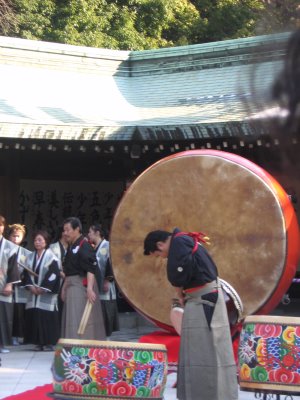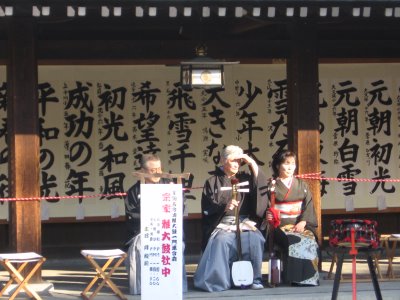Meiji Jingu
Right next to the shopping haven and teen heaven of Harajuku is the Meiji Shrine, a Shinto shrine which was originally built around 1920, but was destroyed during bombings of Tokyo during World War II and was rebuilt in 1958. It's quite a peaceful place despite the crowds of people rushing in to pay respects to the Emperor Meiji and his Empress Shoken, who are both enshrined there. According to the shrine's official website, it sits on a 700,000 square-meter forest that contains more than 120,000 trees, which is a nice escape from the sparsely greened city I've grown accustomed to on my walks to and from school. Yoyogi Park, one of Tokyo's other green spaces, is just beyond the forested area, and from what I hear, it's a hot spot for picnicking in spring. The first time I visited Meiji Jingu, I was treated to melting ice sculptures and the second, then we were able to see a taiko drumming performance.
Walkway toward the Main Shrine area
This is a torii, a gateway to a Shinto shrine. This one is made from 1700 year-old cypress planks.Traditional couples will present their newborn babies to the gods here on Thursdays.
This is the main sanctuary, where the Emperor and Empress are enshrined. People walk up to
this point, meditate, and throw 5-yen pieces into an offering table to pay their respects.
this point, meditate, and throw 5-yen pieces into an offering table to pay their respects.
Most of the drummers in this performance were women of various ages, which was kind of neat.
Taiko (taiko literally means "drum") were used in order to set a marching pace in battle, much like drums were used to similar effect in colonial America, Civil War U.S., and in other European nations, but its earliest use in Japan was to ward off evil spirits and pesty creatures from the crops and used as a celebration of a bountiful harvest. Now it is a colorful display of sound and movement; this performance incorporated traditional Chinese lion dancing, as two lions battled it out to the sounds of the taiko and the plucking of shamisen, a stringed lute-like instrument.
While the shamisen was played here in a traditional manner, we were able to see more modern shamisen playing at a sake tasting last Friday. There the shamisen player was accompanied by beatboxing. It really was a cool effect, and more selfishly, it made it a lot more listenable for those of us not accustomed to traditional Japanese music.
Traditional shamisen players...
And shamisen with beatboxing background sounds













2 Comments:
Kristina: I love your blog. Obviously your camera has a higher resolution than mine. You can tell you're an expert, while I'm still learning. Thanks for sharing!
Great pictures, Kristina!
Post a Comment
<< Home